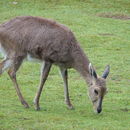en
names in breadcrumbs


The author wishes to thank Dr. Lynn Irby, from Montana State University, for providing me with his work on mountain reedbucks.
Mountain reedbucks will use a shrill whistle to indicate danger nearby. They will also use a whistle to warn other animals of its home range along with scent and visual displays.
Communication Channels: visual ; acoustic ; chemical
Other Communication Modes: pheromones ; scent marks
Perception Channels: visual ; tactile ; acoustic ; chemical
Hunting of mountain reedbucks must be managed carefully since the animals do not move to areas of high productivity. Hunting has not been shown to be a major factor in negatively impacting populations of mountain reedbucks, but it has been in other ungulate populations. The mountain reedbuck is listed as conservation dependent by IUCN.
US Federal List: no special status
CITES: no special status
IUCN Red List of Threatened Species: least concern
Mountain reedbucks can compete with domestic livestock for available grazing habitat, but for the most part they inhabit areas that are undesirable for cattle.
Mountain reedbucks possess qualities that make them a challenge for sport hunting and are sought after for their venison. They are also an important animal for wildlife viewing. According to Irby (1975), mountain reedbucks represent a species that should be encouraged in the Cape Province for its ecological, recreational, and aesthetic values.
Positive Impacts: food ; ecotourism
As folivores, mountain reedbucks provide an important link in food webs. they are hunted by lions, leopards, wild dogs, jackals, and caracal, and sometimes baboons. Therfore, as a prey species, they potentially impact the populations of predators. They probably also influence the growth of vegetation through their own foraging behavior.
Mountain reedbucks have been recognized as roughage grazers that primarily feed on grasses. In one study monocots constituted 99.5% of the material found in the rumen. Mountain reedbucks possess the ability to selectively graze to obtain the highest nutrition from a low quality diet.
Plant Foods: leaves
Primary Diet: herbivore (Folivore )
Mountain reedbucks inhabit three separate geographic areas, each containing a recognized subspecies. Southern mountain reedbucks are found from the eastern Cape Province to southeastern Botswana. Throughout history some populations have disappeared in this range for various reasons. The East African subspecies (Chanler's Mountain Reedbuck) is found in Tanzania, Kenya, Uganda, Sudan, and Ethiopia. The West African subspecies has only been found in Camroon.
Biogeographic Regions: ethiopian (Native )
Mountain reedbucks are normally found in hilly, broken terrain with grasses dominating the ground cover. They inhabit areas with scattered trees with water sources nearby. They will use flat terrain adjacent to hilly and broken terrain.
Habitat Regions: terrestrial
Terrestrial Biomes: savanna or grassland ; scrub forest ; mountains
Although no lifespan has been reported for R. fulvorufula, another species in the genus, R. redunca is reported to live as long as 18 years in captivity. It is likely that mountain reedbucks are similar.
In one study the number of carcasses found increased during the late winter period which indicated the animals are in bad condition in winter leading to higher mortality. This also indicated mountain reedbuck are more vulnerable to predation during times of low productivity.
Average lifespan
Status: wild: 12.0 years.
An adult male mountain reedbuck is about 70 cm tall at the shoulders and weighs 30 kg. The species is characterized by short curved horns. Adult female mountain reedbucks are smaller than males, but both sexes have grayish brown hair on the body, rufous necks, white undersides, and a bushy tail with a white underside. Both males and females also display a dark scent patch underneath the ears.
Average mass: 30 kg.
Other Physical Features: endothermic ; homoiothermic; bilateral symmetry
Sexual Dimorphism: male larger; ornamentation
Average mass: 30000 g.
Predators of the mountain reedbuck include lions, leopards, wild dogs, jackals, and caracal, and sometimes baboons. There is currently no evidence to show predation as a limiting factor on reedbuck populations. The only predator that may pose a threat to the populations is humans and the over-hunting of mountain reedbuck.
Known Predators:
Redunca fulvorufula is polygynous. Reproduction throughout the year can be observed in mountain reedbucks but the peak of the breeding activity is in summer and autumn with the peak of the lambing season during the summer rain periods.
Mating System: polygynous
Female mountain reedbucks can experience first estrus at 9 to 12 months, but most do not experience it until 12 to 24 months. Males produce viable sperm at 1 year. Lambing intervals run from 9 months to 14 months with the gestation period normally eight months. One lamb is typically born at a time.
Breeding interval: Mountain reedbuck have breeding intervals of 9 to 14 months.
Breeding season: Breeding typically occurs in summer and autumn.
Range number of offspring: 1 (low) .
Average number of offspring: 1.
Range gestation period: 7.87 to 8.37 months.
Average gestation period: 8 months.
Range age at sexual or reproductive maturity (female): 9 to 24 months.
Average age at sexual or reproductive maturity (female): 12 months.
Average age at sexual or reproductive maturity (male): 1 years.
Key Reproductive Features: iteroparous ; seasonal breeding ; gonochoric/gonochoristic/dioecious (sexes separate); sexual ; fertilization ; viviparous
Average birth mass: 3000 g.
Average number of offspring: 1.
Average age at sexual or reproductive maturity (male)
Sex: male: 335 days.
No information was found on parental care of the mountain reedbuck. However, in general, bovids produce precocious offspring which are able to follow the mother from a very early age. The female provides her young with milk until weaning. Because the interbirth intervalis about one year, it is safe to assume that at offspring is weaned before it is a year old.
Parental Investment: no parental involvement; altricial ; pre-fertilization (Protecting: Female); pre-hatching/birth (Provisioning: Female, Protecting: Female); pre-weaning/fledging (Provisioning: Female, Protecting: Female); pre-independence (Protecting: Female)